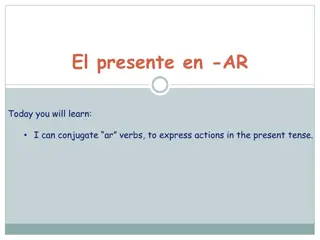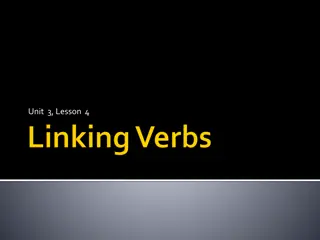Understanding Irish Grammar: Past Tense Verbs and Questions
Delve into the intricacies of forming past tense verbs and asking questions in Irish grammar. Learn the rules for changing broad and slender verbs, both one and two syllables long. Discover how to form questions and negatives in the past tense, along with a quick recap of key points for easy reference.
Download Presentation

Please find below an Image/Link to download the presentation.
The content on the website is provided AS IS for your information and personal use only. It may not be sold, licensed, or shared on other websites without obtaining consent from the author. Download presentation by click this link. If you encounter any issues during the download, it is possible that the publisher has removed the file from their server.
E N D
Presentation Transcript
Gramadach cuid a naoi
An Aimsir Chaite Inn (The Past Tense - Yesterday) 2 syllable slender verbs Before you start, always check if the verb is broad or slender. Remember, if the last letter in the root of the verb is a,o or u, then the verb is broad e.g. tosaigh = broad verb. If the last letter in the root of the verb is i or e, the verb is slender e.g. irigh = slender verb. The rules for changing verbs to past tense are the same for one syllable verbs and two syllable verbs. For verbs that start with a consonant, add a h after the first letter e.g. Cruinnigh - to gather = Chruinnigh m - I gathered. For verbs that begin with a vowel, put D in front of the verb e.g. oibrigh to work = D oibrigh m I worked. Verbs that begin with F take a D and a h e.g. Foilsigh to publish = D fhoilsigh I published.
An Aimsir Chaite Inn (The Past Tense - Yesterday) 2 syllable slender verbs The only difficult part is when we want to say we did something in the past tense. With broad 2 syllable verbs in the past tense, there are three steps. 1. Drop the gh part from the verb 2. Put a fada on the i 3. Add omar e.g. cruinnigh e.g. cruinn e.g. cruinn omar we gathered Alternatively, you can drop the igh and add omar for 2 syllable broad verbs e.g. cruinnigh = cruinn omar
An Aimsir Chaite Inn (The Past Tense - Yesterday) 2 syllable slender verbs Ceisteach agus Di ltach (Questions and Negative) To ask a question in the past tense, we put Ar before the verb e.g. Ar chruinnigh t ? (Did you gather?), Ar irigh t ? (Did you get up?), Ar oibrigh t ? (Did you work?)* To say that you didn t do something, we put N or before the word e.g. N or chruinnigh m (I did not gather), N or fhiafraigh m (I did not ask)*, N or eirigh m ? (I did not get up)* *Notice how we don t use d when using the ceisteach agus di ltach
An Aimsir Chaite Inn (The Past Tense - Yesterday) 2 syllable slender verbs Quick Recap: 1. For verbs that begin with a consonant, add a h after the first letter e.g. ceannaigh = cheannaigh m 2. For verbs that being with a vowel, put a d in front of the word e.g. oscail = d oscail m 3. For verbs that begin with an f, put a d in front of the first letter and a h after it e.g. fiafraigh = d fhiafraigh m 4. For verbs that begin with l, n and r, no change is made in the past tense e.g. rith = rith m 5. To ask a question, we use Ar. To say the negative, we use N or. 6. To use we in the past tense, add a h, drop the gh , change the i to a and add omar e.g. ceannaigh = chruinn omar.























